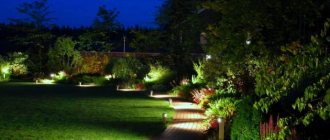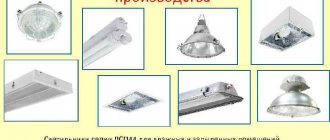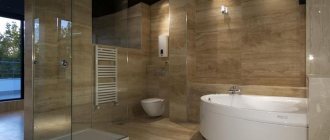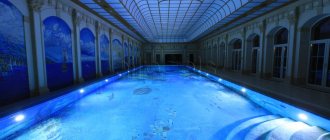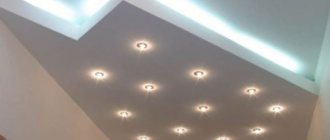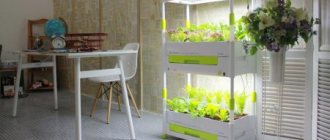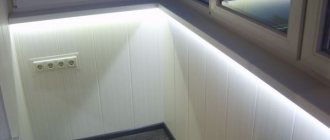Basic requirements for site lighting
The organization of the lighting system should be carried out taking into account various factors, so that at night the summer cottage is not only safe, but also does not lose its aesthetics. The following requirements are put forward for lighting of dachas and courtyard areas of country houses:
- safe electrical wiring, the presence of an RCD and a circuit breaker in the circuit;
- convenient lighting control;
- all system components, incl. lanterns, light bulbs, switches must be intended for outdoor use, be moisture and dustproof. Cable laying is required in a corrugation or pipe;
- All areas of the dacha need to be illuminated; ideally, in the evening and at night the boundaries are perfectly visible;
- use of energy-saving light bulbs. This point is especially important if outdoor lighting is required daily.
In addition, you will need to develop a lighting scheme for the area. This must be done according to a certain rule.
Attention!
It should be drawn up before the start of landscape design work. Otherwise, when laying cables, you will have to destroy existing elements.
What is the secret to creating the right lighting?
Truly, garden lighting is akin to art - it can create unprecedented effects that are born from the union of plants and decorative lighting. You just need to bring to life some “educational” ideas for your dacha - with your own hands you can transform your garden so much that from being inconspicuous, no different from many others, it will turn into a fabulous corner that can touch you at any time of the day.
Evening lighting of the dacha will not only give the garden a certain mystery, but will also allow you to move around the site without fear
Your garden house and country landscape will look natural during the day and mysterious in the evening if you successfully combine the functionality of lighting with its decorative effect. What tasks are assigned to lighting a garden plot? Depending on the function and area of placement of external lamps, the following types of dacha lighting can be distinguished:
- home lighting;
- track lighting;
- lighting of stairs;
- accent lighting;
- patio lighting;
- festive lighting;
- security lighting.
An important condition for the correct organization of a dacha lighting system is the preservation of the aesthetics of the garden during the day, that is, lamps for night illumination should not disturb the harmony of the dacha landscape. To fulfill this condition, it is enough to select lighting fixtures with a natural shape and/or made from natural materials. A widely used technique for decorative garden lighting is luminous stones, which absorb solar energy throughout the day and release it at night in the form of a mysterious glow, flowing softly, as if from within a rock.
Original lighting placed in dense vegetation will create a cozy atmosphere in a secluded relaxation area
Aerial butterflies and dragonflies, glowing in the dark, naturally and unobtrusively coexist with garden plants
Or maybe you would prefer a group of bright butterflies on long twigs stuck into the ground, which will enliven the lawn during the day and glow at night? What do you think of a gnome with a lamp suddenly peeking out from behind a bush, or a glowing frog perched under a large leaf? Such original solutions will give your dacha individuality and originality, to your delight and to the good envy of your neighbors.
In addition to the artistic impression, it is necessary to think through the technical side of lighting the dacha. The use of alternative light sources based on solar energy is the most economical option for garden lighting. In addition, this type of lighting will not spoil the appearance of the site with long electrical cords stretching along flower beds and paths, since it consists of an autonomous battery pack and a group of lamps connected to it.
The unusual illumination of trees in the form of luminous wells is so mysterious that you inexorably want to look into this depth
Artificial flowers in the form of solar-powered lamps will harmoniously fit into the landscape design of the garden
It is more logical to place backlights connected to the electrical network closer to the house - to illuminate the facade, entrance lobby, terrace, since these areas require more active light, and laying a short wiring will not require significant labor costs and financial investments.
Drawing up a lighting plan for the area
Due to the large assortment, making a choice is quite difficult. I want to use everything at my summer cottage:
- decorative type lanterns;
- illuminated garden figures;
- lamps with moonlight;
- colored lanterns designed to decorate tree crowns;
- garlands, etc.
All this can cause chaos, which can be avoided if you think in advance about the main locations of the lamps, their number, dimensions, determine the functionality of the lighting and choose the style of lighting fixtures.
To do this, you need to draw up a plan diagram of the location of all the lamps on the site. For this purpose, you can use a photocopy of the territory diagram or draw a scale plan indicating all existing buildings.
Attention!
It is necessary to create a lighting plan in parallel with thinking through the remaining elements of landscape design.
The locations of future lamps are determined along with the design of gazebos, garden paths, ponds, patios, terraces and other recreation areas. If you don't do this, there is a good chance that you will have to redo some of these elements due to the need to run power cables.
You will need to draw up an electrical connection diagram: anyone who has at least a little knowledge of electrics can handle this task. But the entire lighting system must be installed by a professional so that it is safe for summer residents.
How to competently create a project
Carelessly designed outdoor garden lighting leads to installation errors, which results in time-consuming rework and unnecessary costs. The most important point of the project is power supply and proper cabling.
The project includes:
- schematic diagram;
- single line diagram;
- route plan;
- electrical equipment specification;
- final estimate.
The project guarantees fast and high-quality installation work, and in the future, in the event of system malfunctions, it facilitates troubleshooting.
Step-by-step creation of lighting along paths
When creating lighting for garden paths with your own hands, you must adhere to the rule that the light of the installed lamps will be evenly distributed along the entire path and will not shine into your eyes. The procedure looks like this:
- Site preparation.
- Definition with power supply. Calculation of wire cross-section and power of machines.
- Selecting the type of lamps.
- Sketching the diagram.
- Installation of lamps.
- Connection of all elements.
To control lighting, conventional automatic machines located on a common switchboard can be used. In addition, the light can be turned on using automation (motion sensors, light-sensitive relays, etc.).
Decorating the house
To illuminate the garden house, wall lamps are used, as well as light sources located outside the building. Building lighting can play the role of festive illumination. LED garlands stretched along the contour of the building and the perimeter of the windows create a unique effect. The house gets a no less original look when it is illuminated by lamps located at its foot.
Decorating trees
When creating garden lighting, tree lighting has an aesthetic and functional purpose. At this point in landscape design, two main directions are highlighted, in which:
- trees are illuminated from below using spotlights installed on the ground;
- lamps are located directly in the crown of trees.
In the latter option, LED garlands are most often used.
Lamps on and near trees allow you to highlight an alley or highlight the beauty of a separate green space.
Types of site lighting
The lighting of a suburban area is assigned several functions simultaneously, for each of which a separate type of lamp should be provided.
Functional
The tasks of functional lighting are simple and clear. If decorative lighting cannot be used in every summer cottage, then it is impossible to do without general lighting. When highlighting all the important elements to increase the safety of movement around the territory, it is worth remembering that the accents in lighting should be placed on gazebos, patios, houses and other buildings.
Attention!
Garden paths should not be flooded with too much light so that those walking along them experience discomfort.
The most illuminated place on the site is the facade of the house and the porch: it will be more comfortable to move from less illuminated areas to brighter ones. Even late at night, functional lighting should allow you to see the boundaries of the site.
It is also necessary to highlight stairs, curbs, bridges and other most dangerous objects. Lamps should be placed evenly along the paths. The light source can be lanterns, floor lamps with frosted glass diffusers, bright spotlights, spherical lamps and other elements.
Decorative
This type of lighting is needed for recreation areas and objects that you want to admire even in the dark. Often, additional lighting is installed on flower beds, trees, shrubs, fountains, ponds, alpine slides, garden sculptures, as well as gazebos, patios and benches. Decorative lighting complements the main lighting and provides dim light, creating a romantic and slightly mysterious atmosphere. There are many ways to organize it - it all depends on the style of the site and the imagination of the owner.
To choose the right style of lamps for your garden, you can use a simple rule. The more elaborate and diverse the landscape design of the garden, the simpler and more concise the lighting items should be. If the style of the site is close to minimalism, then you can use lamps of the most bizarre and non-standard shapes, placing the emphasis on them in decorating the garden.
What and how should be illuminated on the site?
Lighting devices on the site must be strong and durable: they will perform their function in frost, snowfall and heavy rain. It is also necessary to maintain balance. If there are many buildings and plantings on the site, the lighting should be invisible. But if the design of the site is simple, then you can choose large lamps.
It is correct to design landscape lighting before arranging the garden. In addition to the number of lamps, their type and required communications, it is important to take into account the direction of the light flows. Their intersection will lead to the formation of large light spots that will spoil the overall appearance. It is not practical to position street lighting so that light enters living rooms and bedrooms. And if a poorly placed lantern shines into a neighbor’s house, it will cause discomfort and can ruin relationships.
For the finished site, lighting should be selected taking into account the location of green spaces, paths, decorative elements and functional buildings. Among the elements of the site that need lighting, we will consider the most important ones.
Accent elements: gazebos, patios, barbecue area. Here you can use decorative lighting. Diffused two-level lighting is often used. This is a relaxation area where it is important to create a warm, cozy atmosphere, and at the same time see objects in poor lighting.
Garden paths. The purpose of lighting is to highlight all the irregularities and turns. For this purpose, both lanterns and bollards of different heights are used, as well as lamps mounted in tiles or borders.
Decorative elements. These include rockeries and rock gardens, ponds and pools, flower beds, stairs and steps. Most often, diffused light devices, garlands, and LED strips are used to illuminate them.
The buildings. Multidirectional light will emphasize the color and texture of architectural objects on the site, help hide flaws and highlight advantages, and visually change the volume and size.
Trees and plants. Illumination of green spaces and flower beds creates a magical atmosphere. If there are topiaries on the territory, decorative lighting will turn them into fairy-tale creatures.
When designing landscape lighting for a country house, do not forget about the direction of the light. It is by combining the type of light flux and its direction that it is possible to create unique lighting solutions. In summer cottages, different methods are used for lighting:
- Frontal: The subject is illuminated from the front and the light is evenly distributed over the entire area, causing the subject to appear flat.
- Outline: the object is illuminated from behind, the light emphasizes its strict silhouette, but it is almost impossible to make out the texture and color.
- From above: Light is directed from under the roof or from high supports, creating a variety of combinations of illuminated and shaded areas.
- Bottom: The light comes upward, making objects look unusual.
- From the side: light is directed tangentially, emphasizing perspective and emphasizing the alternation of shadow and light. This method is used to illuminate hedges and topiary.
- Intersecting: light is directed at the subject from two sources (top and bottom, right and left), highlighting it and giving it volume.
- LED: this non-electric method of lighting objects and areas works for a long time and is indispensable outside the city. Such lamps can be mounted on walls and trees.
Lighting a summer cottage is a great way to demonstrate the individual style, imagination and aesthetic taste of the home owners. Thanks to the correct selection and location of lighting fixtures, the house and surrounding area will always be reliably protected.
The main types of lamps for the garden
It is desirable that the illumination of the area be a stylish and functional addition to it, and also not become a source of high electricity costs. Traditional incandescent lamps cannot be called the most economical option, because... During operation, they become very hot, which consumes most of the energy, quickly burn out, and at low temperatures can even explode. You can replace incandescent lamps:
- luminescent and halogen devices, characterized by economy and long service life;
- LED lamps and strips do not heat up, consume minimal energy, shine quite brightly, and in terms of durability they confidently outperform competitors. In addition, when using this type of lamps, you can easily change the brightness of the lighting. Often, decorative lighting is created using LEDs, arranging hidden lighting for ponds, steps, benches, the facade of a house, or hiding them in the crown of trees or shrubs;
- fiber optic systems are a new word in the field of garden lighting. Can be used as sources of main or additional light, architectural lighting or decoration of pools and ponds. Such a system consists of a projector (light source for the optical fiber), an optical cable or fiber, a common input, threaded attachments and various terminal devices. It turns out that with just one generator it is possible to provide lighting to a large area. The main advantages of the system: ease of operation, long service life, cost-effectiveness and the absence of requirements for waterproofing of lamps.
Separately, it is worth highlighting such non-standard modern solutions for garden lighting, such as paving slabs with LEDs built into them and fluorescent tiles with the ability to accumulate solar energy during the daytime.
Types of lamps and lanterns
Such lighting devices are used for street lighting.
- Spotlight. Emits a powerful cold-type light beam. Equipped with a rotating mechanism, so you can change the direction of the beam. It can be ground or wall mounted. Used for accent and protective lighting. The design is simple and does not draw attention to the lamp.
- Ground spot. A small, dim flashlight built into the lawn or path tiles. Serves for soft illumination of paths and flower beds.
- Decorative. It has an unusual attractive design and is an important element of garden decoration. Happens:
- ground;
wall;
- hanging;
- built-in;
- floating, as a rule, provides little light.
- Lantern on a stand or “bollard”. A popular type of lamps for installation along garden paths. Emit soft diffused light.
LED, halogen and conventional incandescent lamps are used as a light source. LED devices are the most economical in energy consumption and the most durable.
Full information about the types of lanterns is here.
Types of street lamps by installation location
A wide range of lamps for lighting a summer cottage and the territory of a private house can be divided into several groups:
- floor lamps - lanterns of different heights;
- wall lanterns - they are used to illuminate a house or fences; they can be hung on the wall at any height;
- pendant lamps - lanterns and garlands that can be hung from tree branches or ceilings in gazebos;
- spotlights with a directional beam of light - installation is often carried out at ground level. They are necessary to illuminate those areas that need to be highlighted on the site;
- indirect lamps (lanterns with a reflector) - direct the light flux downwards, therefore they are used to illuminate garden paths and flower beds.
Fiber optic luminaires are placed in a separate group due to their unique properties and versatility of use.
Decoration of house facades and small architectural forms with lamps
1. It is very convenient to place lamps on the walls of the house from the outside, in this way you can decorate the central entrance to the house, illuminate the balcony, as well as the entrance to the gazebo, garage, barn. Such lighting will not only decorate the area, but will also save money, since the cost of lamp posts and electrical cables will be reduced.
2. Recently, LED strips for street lighting have appeared. They can effectively decorate the outline of a building, windows, doors.
There are ribbons of various colors and types:
- contour – they emit light constantly, they are good for highlighting the geometric shapes of a building;
- dynamic - create flickering and blinking, they are usually used to decorate the facade during the New Year holidays;
- hidden or semi-hidden tapes - provide diffused light, and are usually used to decorate convex and concave parts of the facade.
3. You can decorate a pergola, trellis, statue or tree trunk with a luminous tape, then you will have a dominant point in the night garden that will attract the attention of visitors. And if the tape is laid along the retaining wall, it will not only perform a decorative function, but also warn about changes in levels. This technique will protect hosts and guests from possible injuries.
Types of lamps by light source
Lamps according to light source are:
- electric. They form the basis for lighting the area, are the most functional and require preparatory work, which includes digging trenches and laying cables in plastic or corrugated tubes;
- Solar-powered lanterns are an original and quite economical way to illuminate certain areas of the site. Such lamps can only be used as a supplement to electric lighting. During the day they accumulate energy from the sun, and at night they emit a soft, pleasant light. Installation is simple - the lamp is mounted where additional lighting is needed, there is no need to dig trenches, and if necessary, it can be easily moved to another place. Such lamps can be of any size, shape and design, they are expensive, but they do not use electricity. The battery will charge even in cloudy weather;
- objects painted with luminescent paint are a non-standard way to decorate your area and diversify its decorative lighting;
- open flame. Candles hidden in beautiful lampshades can be used to create a romantic atmosphere. Another option is kerosene lamps. This is a purely decorative source of lighting, which must be constantly monitored to prevent fire.
Types of lamps
Garden lamps differ in lamp types, location/mounting, shape, and power supply. They are made taking into account protection from negative environmental factors. The main criteria for garden light sources are protection from moisture, dust and mechanical damage.
Among the lamps used in lighting the local area and garden area are:
- incandescent Gradually falling out of use. At a relatively low cost. They have a small resource and wasteful consumption of electricity;
- luminescent. Provides uniform illumination. Allows you to experiment with luminosity temperature. With relatively low energy consumption, they create problems with disposal;
- LED They are distinguished by low power consumption and long service life. Offers a wide range of colors. Allows you to create unusual light compositions. Disadvantages include the need for additional equipment, as well as high cost.
Street lamps are attached to the walls of buildings, produced in the form of lanterns, sunk into the ground, placed in decorative ponds, etc. In addition, garden lamps look impressive on trees and shrubs, decorating the landscape and illuminating the surrounding area.
Solar powered
When creating a lighting system for the adjacent territory of a private household, special attention is paid to savings. In addition to the rational distribution of light sources, this is achieved with the help of lamps that do not require a centralized supply of electricity. One of the best solutions in this direction is the use of solar-powered lamps.
The device consists of a photodetector, a converter, a battery and an LED. During daylight hours, the lamp accumulates electricity and is activated at dusk. With a high-quality battery, the energy accumulated during the day is enough to last all night. With the first rays of the sun, the lamp turns off and the device goes into charging mode.
Autonomous
The main advantage of private home ownership is the possibility of complete autonomy. Alternative energy sources supply electricity no worse than centralized networks. In this case, payment for utilities is excluded, and in case of problems, the system created by oneself is restored without outside help.
Autonomous garden lighting provides the following benefits:
- independence from public utilities. Savings on design and installation of networks;
- reducing the burden on the family budget by reducing electricity bills.
- use of renewable (virtually inexhaustible) energy sources
Autonomous lamps are not threatened by weather conditions, wire breaks and breakdowns of transformer substations. The owner's costs come down to preventive maintenance (cleaning) of devices, timely replacement of batteries and lamps.
Wired
Wired garden lights are cheaper than stand-alone lights. With proper network design and high-quality materials, they require virtually no maintenance. The disadvantages of such home lighting include the laboriousness of laying cables and the impossibility of moving it to another location.
Automation of turning on and off country lamps
Even at the stage of drawing up a diagram of the location of lamps on the site, you need to decide how they will be turned on and off. Someone will want to do this on their own every day, but in the case of a large area, it is quite problematic to constantly turn the lamps on and off. This is especially true when you don’t come to your dacha very often. But there is a way out - automation of the lighting system, and there are several options for bringing this idea to life:
- control of a twilight relay, which will turn on the lighting when the sensor installed on the site “feels” the onset of twilight, and turn it off at the onset of dawn. Installation of the sensor is possible in any convenient place on the territory; the relay is mounted in the electrical panel;
- astronomical relay control. In this case, no additional sensor is required - you just need to set the location coordinates once, and the built-in microprocessor will calculate the time of sunset and dawn at a certain time of the year. Such a relay can be additionally configured not to turn on the light if there is no one on the site. Thanks to the built-in battery, the relay retains all settings during a temporary power outage. Mounted in electrical panel;
- controlling a time relay is the simplest and not very functional option. It only adjusts the time after which the light will turn off after turning it on manually. Suitable for areas where there are few light sources. For example, the relay has settings according to which the light must be turned off after five minutes. The owner of the site, having arrived at the dacha in the evening and manually turned on the lighting near the gate, does not have to return to turn it off - the light itself will go out after a specified time.
In addition, at least one lamp in the country must be equipped with a motion sensor. When someone passes within the range of the sensor, the light will turn on. This is convenient if you often come to your dacha in the evening - you don’t need flashlights, candles and matches. In addition, such a solution provides additional protection against entry into the territory of third parties.
Attention!
Motion sensors are often tuned to a specific object size, so they won't go off if a pet runs nearby.
Basically, they function together with a photo relay, which prevents the motion sensor from triggering during the day.
Reasons to use spot lighting
To illuminate large areas, powerful spotlights or spotlights are used. Each of the systems has its own advantages and disadvantages, which are indicated in Table No. 1.
Table No. 1
| Spotlight | Spotlights | ||
| pros | Minuses | pros | Minuses |
| Illuminate a large area with one light source | Blinding light | Soft, comfortable light | Labor-intensive installation |
| Concentration of lighting on a specific object | Uneconomical energy consumption | Economical | |
| Easy installation and maintenance | When a failure occurs, the area is completely deprived of lighting. | If one source fails, the others continue to illuminate the area | |
| Possibility of zone lighting | |||
| Emphasizing individual landscape elements | |||
Although a large number of spotlights are more expensive than one spotlight, when illuminating a garden plot, their use seems more rational.
What to consider when choosing garden lamps?
The lamp in the country will be constantly influenced by negative environmental factors: precipitation, sunlight, high and low temperatures. This means that you need to choose only those products that are intended for outdoor use. They must be sealed or semi-sealed. In the latter case, you will need to take care of the presence of canopies from snow and rain.
When purchasing, you should check whether the inside of the lamp mount is painted or not. In the latter case, you should not count on long-term use. Lamps made of stainless steel and aluminum alloys have proven themselves better in use. Do not forget about the warranty period; ask the seller for a safety certificate, which should indicate the degree of protection.
Rules for choosing lighting fixtures for the yard
In order for your yard to be properly illuminated with lamps, you need to choose them correctly. Be sure to pay attention to the technical characteristics of the devices - they must be moisture resistant and have dust protection.
Don’t forget about efficiency and, if possible, give preference to models that run on solar panels.
If necessary, choose floodlights equipped with LED lamps. This will save significant money.
Original do-it-yourself site lighting
The cost of garden lamps may make some owners doubt that decorative lighting is necessary for the site. If you use your imagination, find some free time and use available materials, you can make original lamps with your own hands.
From glass bottles
- The easiest way is to place a New Year's garland in a non-standard shaped bottle. If you use a battery-powered garland, you can use an improvised lamp away from the outlet. It is possible to replace the garland with a flashlight inserted into the neck, and fill the container of the bottle with beads or transparent reflective balls.
- You can pour sand, pebbles, multi-colored stones into the bottom of glass jars and put candles. The outside of the container can be decorated with rope, fabric, lace, etc.
- A lampshade from a glass bottle of a non-standard shape or color is prepared by cutting off the bottom. There is nothing complicated about this: you need to tie the bottle with a thread soaked in kerosene where you need to make a cut, and pour cold water into the container itself to the same place. All that remains is to set fire to the rope - the cut will be smooth, but if necessary, it can be sanded a little. Now all that remains is to insert the power cord into the bottle, connect the socket and screw in the light bulb.
- The inside of the bottle needs to be painted with luminescent paints, making spots of different shapes and sizes. In the evening, an ensemble of several bottles will look quite unusual.
From tin cans
You can make a custom lamp from any tin can, in which you can place a candle or a garland. The penetration of light will occur through many holes made in the shape of a pattern, make them on the can with nails of different sizes and using a hammer. You can simplify the task if you first make a sketch on paper, which you then attach to the container and transfer the drawing onto it.
It is better to place a piece of wood in the shape of a cylinder inside the can so as not to deform the can when creating holes. Lamps can be arranged or hung around the site.
Made from wood or rope
Stick small twigs onto the inflatable ball, overlapping it randomly. After the glue has hardened, carefully remove the balloon and deflate it.
Attention!
Branches can be replaced with thread or rope.
The result will be cute lampshades of any size, which can be used as a lampshade for a light bulb, or as a way to decorate a regular garland.
Made of plastic
Plastic bottles will help you create lamps of various shapes, colors and sizes - the main thing in this matter is your imagination. A simple ball lamp can be made from the bottoms of several bottles. They need to be cut, glued together, bent along the radius and given a spherical shape. All that remains is to install it on the base with a light bulb and connect it to the power supply.
A cute lampshade can be made from plastic leaves. First cut rectangles from a green bottle, from which you can then cut out leaves; their edges can be melted with a soldering iron to make them more similar to real leaves. From individual elements, you can use wire to form entire branches, which will become a lampshade.
What types of lamps can be used?
Specialized stores and the Internet offer a wide range of lighting fixtures for country houses and gardens. Even if you choose devices for a finished area, you will always find ones that will suit the stylistic design and perform the necessary functions.
Lamps for creating interesting designs in suburban areas include:
- spotlights (for example, façade and LED);
- linear;
- functional (underwater, ground, architectural, wall);
- spherical;
- reflected light lamps;
- bollards and road lights;
- LED strips and garlands;
- light figures and stones.
The listed devices can use the following light bulbs:
- halogen;
- LED;
- fiber optic;
- incandescent, metal halide and mercury lamps;
- luminescent.
Each such lamp performs a specific function in a personal plot. Underwater lights are suitable for a pond or pool. Wall lanterns and facade spotlights will help illuminate the house, gazebo and functional buildings on the site. Reflected light lamps illuminate country paths: they emit diffused light that does not blind the eyes. Bollards are suitable for outdoor garage lighting.
Decorative lighting for the area around the house includes spherical lamps of different shapes and colors. This is an original decoration for the garden in any season; they look beautiful both in the pool and in the snow. Their only drawback is fragility. LED strips will illuminate various decorative elements in an original way, and small luminous stones and figures themselves will act as decoration.
When organizing landscape lighting, different types of light flux are also taken into account.
- Directional light is used in functional or decorative lighting of an entire area or a specific object.
- Diffused light softly illuminates the area at night.
- Local light, or spot light, helps to place visual accents in the design of the local area.
- Hidden light is suitable for ponds, steps and paths.
Linear lamps can be used as a source of hidden light, while spotlights can be used as a source of directional light. Wall lamps will help to point the lighting, and ball lamps will scatter soft, warm light around them.
To illuminate a country house and garden plot, it is not enough to choose beautiful and functional devices. Street lamps must meet a number of technical requirements:
- Landscape lighting works in any weather.
- It's convenient to use.
- Installation and maintenance do not require much effort and time.
- It does not irritate the eyes and creates a pleasant atmosphere.
- The lamps and their technical equipment can be used outdoors.
- Each group of lamps has separate circuit breakers and grounding.
- Together, all devices illuminate the area well and mark the boundaries of the site.
When working on the design of a site or planning lighting in a dacha, do not be lazy to draw up a plan diagram. On it, mark the boundaries of the site, the house, all objects (pond, gazebo, garden, garage, etc.). Add symbols of types of lighting devices (spotlights, lanterns, recessed luminaires) to the diagram legend. It is also advisable to clarify the type of light flux.
Only after this, start designing lighting yourself or with the participation of a designer. You can find inspiration in interior design magazines or study photos on the Internet, but remember that your site is unique. Choose only those design solutions that will decorate your area and home.
Country house lighting from solar power plants
The most convenient option is lighting a summer cottage using solar energy. You can choose two ways: assemble the power plant yourself, purchase the necessary components, or buy a ready-made solution.
Making your own garden lighting from solar panels
If you wish, you can make your own lighting for your dacha using solar panels. But to do this, you need to study the main types of systems, their features and installation subtleties.
Varieties
There are:
- Network. It is distinguished by its affordable price and ease of use. Consists of an inverter and solar panels. The voltage from the latter is transformed into a voltage of 220/380 V. The disadvantage of the system is the need for a support network, without which the operation of the system is impossible. In addition, such a power plant is not very profitable. For example, if the device produces 5 kW, and the cottage consumes only 3 kW, the remaining 2 kW will go into the network, but the meters will count the energy as consumed.
- Hybrid. The system includes solar panels and a controller, a battery and a hybrid inverter. The main element is an inverter, which “mixes” the energy of the external network with that received from the battery. The optimal mode is when the cottage is powered by stored electricity and only when necessary switches to an external network (for example, in cloudy weather or when discharged). Allows you to sell excess electricity at a feed-in tariff.
- Autonomous. Its advantage is that it provides power only from the battery without an external voltage source. The system may include an autonomous inverter, battery, solar panels / controller.
Sometimes, additionally or separately, a low-power hydroelectric power station, a generator (gasoline, gas, diesel) or a wind power plant are installed, providing energy to the facility and charging batteries.
Controller - what is it
Regardless of the type, the solar power plant is equipped with a special controller.
This device is connected in series to the electrical circuit between the solar panels and the battery, and monitors the functioning of the latter (the degree of charge and discharge, the supplied voltage, dynamically regulates the supplied current to the battery during charging, etc.).
Principle of operation:
- Solar panels produce a voltage that is a multiple of 12 V.
- The controller receives the voltage and converts it to the required value.
- A suitable voltage parameter is transmitted to the battery, inverter, converted to 220 volts and then supplied to the electrical network of the summer cottage. The sequence of current flow depends on the type of system used (stand-alone, hybrid or networked).
This is a simplified diagram, but it allows you to understand the principle of operation of the controller.
However, they come in two types:
- PWM They operate with solar panels whose voltage does not exceed the parameter required for the battery.
- MPRT. Even clearly overestimated voltage is processed. They have higher efficiency and, accordingly, have a higher price.
Solar panels
They consist of the following components: mono- and polycrystalline, amorphous.
The panel includes:
- glass;
- EVA film;
- solar cell;
- “sealant” film.
Each of the elements is selected taking into account increased requirements. For example, glass must have special fittings that reduce light reflection and refract light at an angle.
The EVA film must have the necessary transparency, because the amount of energy falling on the element depends on this.
The elements themselves also differ in quality. They come in types Grade, A, B, C, D (the highest quality option is A). The finishing film must be of optimal quality and cover the surface tightly.
Solar panels also differ by manufacturer. Most often these are China and the Russian Federation. When choosing a manufacturer, it is necessary to assume that the solar panel has passed a full test cycle and meets the declared characteristics.
DIY collection rules
Before purchasing and installing, you need to calculate the complex in order to avoid mistakes with its placement and laying of cable products.
General algorithm of actions:
- Route the cable between the inverter and solar panels. If there is a large distance between the elements, it is necessary to lay the cable with a margin of thickness and current.
- Install the panels on the guides. As the latter, you can use aluminum corners installed using homemade fasteners.
- Connect the panel units in series. For connections, you can use good connectors that guarantee excellent contact and tightness.
- Charge the battery. This can be done using a car charger.
- Connect the battery to the inverter. To do this, use a 25 square cable. It is worth considering that at the first connection you may notice a spark. Polarity confusion is not a big deal. The cross-section is sufficient for 100-110 A, which will occur when connecting a five-kilowatt inverter.
- Connect the load at home and the external network.
- Connect solar panels. The main thing here is to connect “+” and “-” correctly.
- Turn on the inverter, then configure the battery type, operating mode, charging currents and other data.
- For convenience, install a utility on your computer that shows the operation of the inverter online.
Purpose of lanterns
The installation location of lamps in the yard is determined by the need to illuminate a particular area: the entrance, garden path, flower bed or pond. Depending on the tasks assigned, yard lighting devices can be divided into several categories.
Functional
The main task of functional lighting is to provide sufficient visibility in any area. Thanks to this type of lighting in the yard, you can ensure safe movement after dark.
Various types of lighting equipment can be installed for street lighting:
- Lamps and spotlights installed on the facade of a building or free-standing supports help illuminate garden areas, local areas, etc.
- Landscape street lights - characterized by low legs or direct installation in the ground, provide visibility of paths of buildings and structures in the yard.
- Floor lamps for street lighting are located at human height and are designed to illuminate a small area around, roads, driveways, entrances, gardens and other elements.
In addition to a powerful luminous flux, functional lighting must also ensure minimal energy consumption, so it is worth using LED lights here.
Security
Designed solely to prevent unauthorized entry of strangers into or near the yard. Used to illuminate any area of your home, space, area, etc. Constantly switching on the light at the entrance gate, fence or generally around the perimeter provides good visibility, but this is too expensive. Therefore, it is advisable to automate security lighting using a motion sensor, so that the lighting devices act as an alarm system, notifying that a person is approaching.
Decorative
Used to decorate the yard, its individual sections, flower beds, vegetation, ponds, stairs. Street lighting helps to effectively highlight important elements in the garden and act as architectural lighting. For decorative lighting, spotlights, spotlights, and LED strips are equally used. An important criterion when choosing specific equipment is its compliance with the landscape design and the general style of the buildings in symbiosis with which they will be used.
Festive
Festive courtyard lighting is intended to decorate the area for a specific event - New Year, birthday, etc. Unlike the previous type, they are installed temporarily - in relation to some holiday. Here you can also use architectural lighting, lighting paths, decorating gazebos and terraces. Garlands, LED strips and themed lamps are used as courtyard lighting devices.
Wind power plants for summer cottages
The topic of wind power plants is very broad and requires special attention. Such power plants are used for dacha lighting less often than solar panels, but this option should not be completely ruled out.
Components
The wind power plant includes:
- Blade rotor. There can be 2, 3 or more blades.
- Gearbox. Changes the rotation speed between the generator and the rotor.
- The “tail” of the windmill directs the structure into the wind.
- Frame. Protects internal elements of equipment from mechanical impacts.
- Battery. Accumulates electricity and releases electricity under adverse weather conditions.
- Inverter. Converts direct current to alternating current.
Classification
Wind turbines are classified according to several criteria that must be taken into account when choosing equipment.
In the direction of rotation of the blades:
- horizontal;
- vertical (more stable).
Number of blades:
- two;
- three;
- multi-lobed.
According to the material:
- hard;
- sailing (more affordable, but less durable).
Control type:
- fixed step;
- changing step.
Operating principle
A wind power plant works on the following principle. The wind rotates the blades fixed on a metal mast. As a result of rotation, the generator rotor begins to work, which produces alternating current.
The latter enters the converter, where the alternating voltage is converted into direct voltage. A wind of 4-5 m/s is sufficient for operation.
According to the operating principle, wind generators can:
- Work in parallel with solar power plants (batteries), gasoline (diesel) generators, backup batteries.
- Autonomous.
Selecting the size and installation location
When choosing dimensions, it is necessary to determine the amount of energy consumed. For the calculation, the formula is used: AEO = 1.64*D*V, where:
- AEO - the amount of electricity consumed per year;
- D—rotor diameter (m);
- V is the average annual wind speed (m/sec).
Taking into account the information received, a decision can be made on the parameters of the wind turbine.
When determining the installation location, consider the following:
- There should be no trees, buildings or other objects nearby that could interfere with the work.
- Installation is carried out on a special structure, which must be several meters higher than the obstacle located at a distance of at least 200 m.
- The distance from the windmill to residential buildings is about 30-40 m to reduce the sound from the rotation of the blades.
Wind power plants have certain advantages. Their effectiveness does not depend on the time of year, and the payback period is 5-7 years. Parts wear out slowly, so the equipment can last more than three decades.
But there are also disadvantages: a high mast, the need for constant maintenance and the risk of equipment damage when weather conditions worsen.
